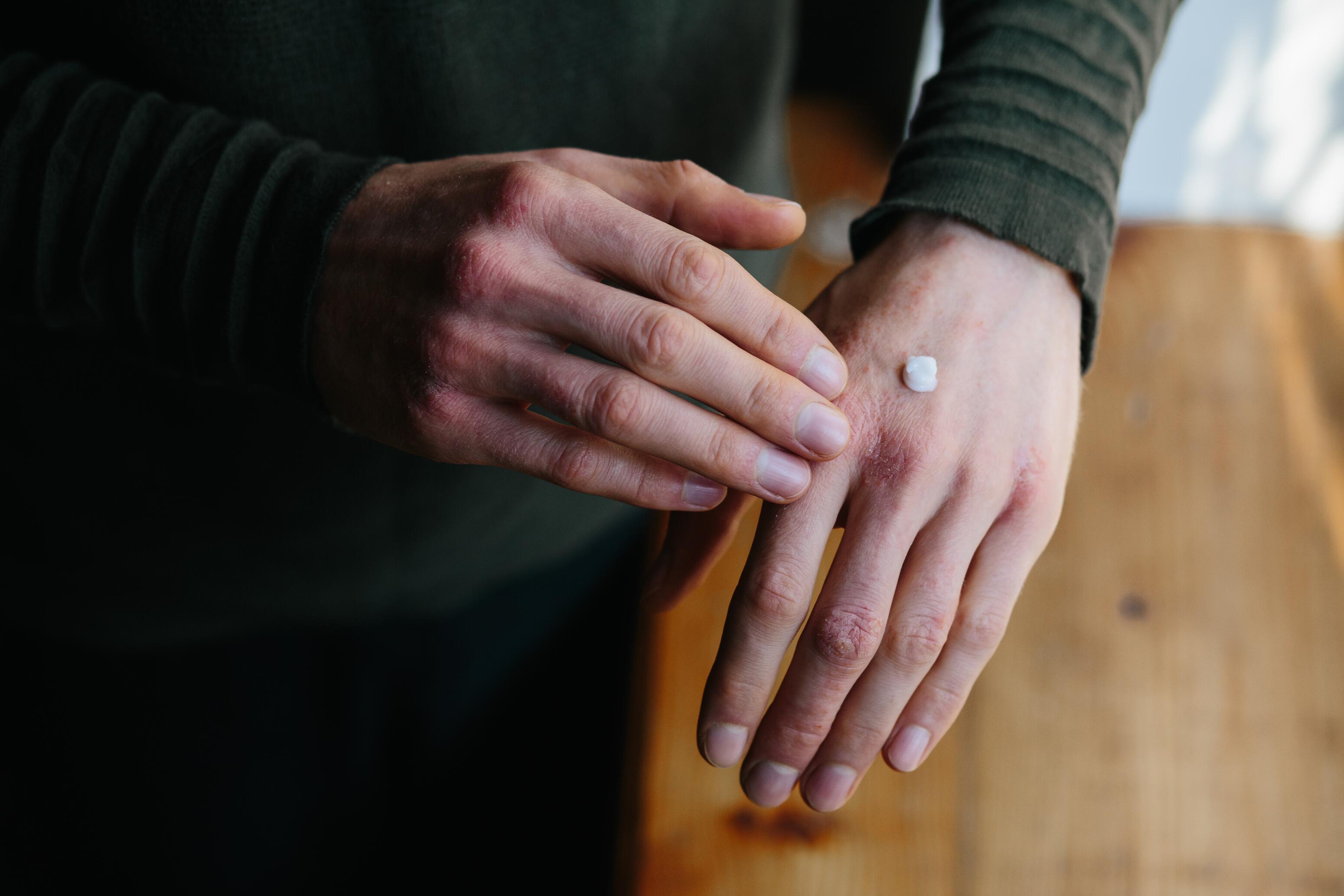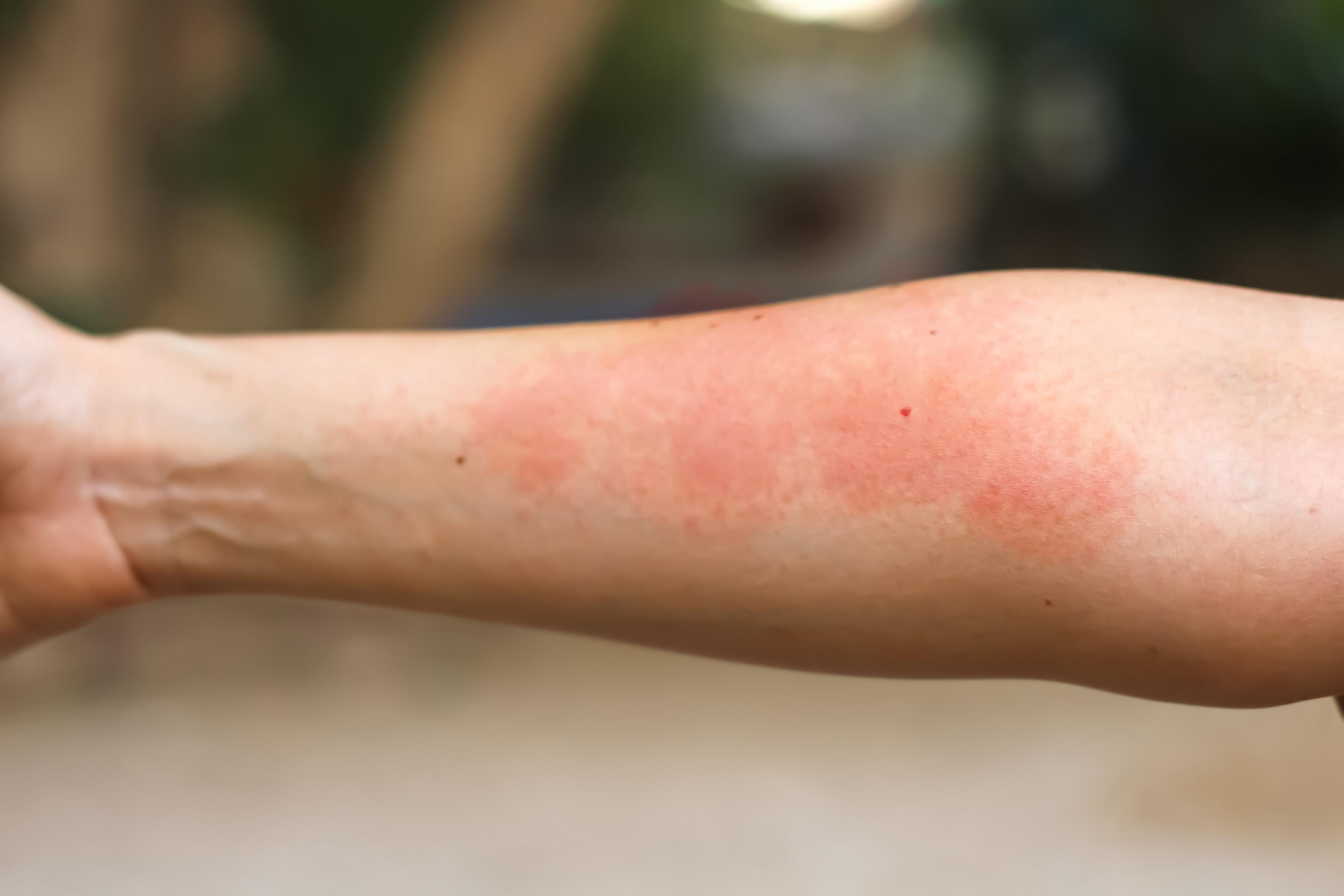Eczema treatments
Explore the most effective treatments for eczema, recommended medications, and preventive measures to avoid flare-ups.
What Are the Main Treatments for Eczema ?
As eczema is a chronic condition, the goal isn't to cure it permanently. Instead, the treatment of eczema and atopic dermatitis aims to manage symptoms during acute phases and minimise the risk of new flare-ups.

Moisturisation1 2
Moisturising the skin using emollients is the cornerstone of treating all types of eczema. Emollients help retain water, improve barrier function, and soothe itching. Applying emollients twice a day across the entire body helps prevent flare-ups and reduces the need for treatment with topical corticosteroids.
Dermocorticoids 1 2 3
Topical corticosteroids are the first line of treatment for eczema flare-ups. They are effective in controlling itching and inflammation but do not prevent flare-ups. These anti-inflammatory treatments are categorised into four levels of potency*:
- Ultra-high.
- High.
- Moderate.
- Low.
The choice depends on the patient (age, skin type) and the lesions (location, extent, severity). Physicians limit the use of potent topical corticosteroids to severe lesions and avoid their application on thin skin (face, eyelids, skin folds, scrotum).

It's crucial to follow the doctor's prescription precisely by applying the topical corticosteroid on eczema lesions until the inflammation (redness, itching) disappears, ideally after a shower or bath. Apply corticosteroids to slightly damp skin to enhance their absorption, and spread it in a thin layer with a light massage for penetration. One application per day is sufficient.
For thick and resistant lesions, particularly on the palms of the hands or the soles of the feet, dermatologists may prescribe topical corticosteroids under occlusion (wrapped under wet bandages) to enhance their effect.
Treatment with topical corticosteroids usually lasts between 1 and 3 weeks. Noting the number of tubes used and taking photos of the lesions between consultations can help the doctor assess eczema evolution.
Although topical corticosteroids have a bad reputation, side effects such as skin thinning are rare and mainly occur after prolonged and excessive treatment. Most treatment failures are due to insufficient topical corticosteroid use (not potent enough corticosteroid, too short or irregular treatment).
Topical Calcineurin Inhibitors1 2
This class of immunomodulatory treatments is used in patients over 16 years old with moderate to severe eczema poorly controlled by topical corticosteroids. Tacrolimus and pimecrolimus (depending on availability in countries) do not carry a risk of skin thinning, even with prolonged use, and are therefore preferred for treating atopic eczema on the face and eyelids.
They are photosensitising treatments, so avoid sun exposure during use. Only dermatologists may prescribe them.
Exceptional Treatments1 2
They are indicated for severe eczema resistant to well-followed topical treatments.

Phototherapy
Phototherapy involves exposing the skin to specific types of ultraviolet (UV) light:
- UVA-1 for treating severe acute eczema lesions.
- Narrowband UVB for treating chronic severe eczemas.
Phototherapy is usually administered by a dermatologist using specialised equipment. The duration and frequency of treatments can vary depending on the severity of the eczema and the effectiveness of the treatment.
It's a safe treatment but requires a doctor's supervision to avoid side effects (burns, pain, itching, pigmentation, and even a long-term risk of skin cancer).
Janus Kinase Inhibitors
Apart from upadacitinib, which is usable from 12 years old, Janus kinase (JAK) inhibitors are reserved for treating adults with moderate to severe atopic dermatitis.
A pre-treatment assessment is necessary to rule out infection or pregnancy, and vaccinations must be current.
Cyclosporine
Cyclosporine is indicated in the treatment of severe eczema in adults. Patients must be closely monitored due to possible adverse effects of the treatment on the kidneys, liver, and blood pressure.
Monoclonal Antibodies
These treatments block pro-inflammatory molecules (cytokines) that steer the immune system towards a Th2-type allergic reaction.
Dupilumab is usable in adults and children from 6 months old, while tralokinumab is reserved for adults and adolescents over 12 years old.
The doctor prescribes a pre-treatment assessment to ensure the absence of infection or pregnancy and can ensure that vaccinations are up to date.
Treatment of Associated Signs and Complications1 2
Doctors can prescribe topical or oral antibiotic treatments in case of bacterial over-infection of eczema lesions.


Psychological Support and Therapeutic Education1 2
Eczema is a chronic condition that can lead to psychological disorders such as anxiety, depression, and ADHD (attention deficit hyperactivity disorder), which can, in turn, exacerbate eczema symptoms through scratching.
Psychological support or relaxation techniques can help break the itch-scratch-flare cycle, especially in teenagers and young adults.
Simultaneously, therapeutic education informs about the nature of the disease, triggering factors, appropriate skincare practices, and self-management strategies to minimise flare-ups. Therapeutic education programmes may include workshops on the correct application of topical treatments, information sessions on the importance of skin moisturisation, and advice on managing stress and anxiety.
How Do Medications for Atopic Dermatitis Work ?
Topical Corticosteroids2 3
Corticosteroids are molecules naturally produced by the adrenal glands. Their action mechanism is anti-inflammatory and immunosuppressive. Via a specific receptor in cells, corticosteroids interact with DNA to promote the production of anti-inflammation molecules and decrease the synthesis of pro-inflammation molecules.
As the gene for the corticosteroid receptor can take several forms, the effectiveness of the treatment and the adverse effects of topical corticosteroids vary from person to person.
Topical Calcineurin Inhibitors2
Tacrolimus and pimecrolimus inhibit the activity of calcineurin, an essential enzyme in activating T lymphocytes, which play a role in eczema's inflammatory and allergic reactions.
Phototherapy
Phototherapy targets skin cells (eosinophils, lymphocytes) that promote the allergic-type inflammation associated with eczema.
Janus Kinase Inhibitors
Janus kinases (JAK) are enzymes that facilitate the action of pro-inflammatory cytokines. By blocking their activity, JAK inhibitors reduce inflammation and eczema symptoms.
Cyclosporine
Cyclosporine is an immunosuppressive treatment which acts mainly on T lymphocytes, JAKs and cytokines.
Monoclonal Antibodies
Type 2 helper T-cell (Th2) immune response is one of the underlying causes of atopic dermatitis, notably through the secretion of pro-inflammatory cytokines IL-4 and IL-13, which lead to skin barrier defects. Dupilumab is an antibody that targets the IL-4 receptor, while tralokinumab acts by inhibiting IL-13.

Does Contact Dermatitis Require Specific Treatment ?¹ ² ⁴
The approach to treating contact dermatitis mirrors that of atopic dermatitis but with added emphasis on avoiding triggers. A healthcare provider—a GP, dermatologist, or allergist—will review the patient's work and leisure activities and any topical or oral treatments before recommending allergy tests to pinpoint the allergens causing contact dermatitis.
Treatment mainly involves skin hydration with emollients and corticosteroids for inflammatory lesions. Contact dermatitis of the hands usually requires high to ultra-high-potency corticosteroids, whereas a lower potency is suggested for facial contact dermatitis flare-ups. Topical retinoids and oral alitretinoin offer additional therapeutic options for facial contact dermatitis.
How to Prevent Eczema Flare-ups ?² ⁵
To minimise eczema flare-ups, consider the following advice.
Look after your skin
- Moisturize daily with an emollient to hydrate your skin and restore the skin barrier.
- Limit showers or baths to once a day with lukewarm water, and opt for gentle, soap-free cleansers.
- Pat your skin dry, avoiding rubbing, and choose cotton clothing over synthetic fabrics or wool.
- Rinse clothes thoroughly to remove detergent residues and steer clear of fragranced fabric softeners.
Skin care
Use of mild cleaners
Pat your skin dry
Avoid synthetic or woollen materials
Eliminate Trigger and Aggravating Factors
- Keep your home cool, steer clear of carpets and rugs, and ventilate regularly.
- Trim your nails often and avoid scratching eczema patches to prevent further lesions and infection.
Advice on limiting the factors that aggravate eczema
Air your home
Keep your nails short
Do not scratch eczema patches
Optimize Your Lifestyle
- If applicable, quit smoking.
- Engage in physical activities that don't cause excessive sweating.
- Following each session, take a lukewarm shower and then apply an emollient.
- In cold, dry weather, apply emollients more frequently.
- Do not alter your diet without medical advice unless a food allergen has been identified.
Common causes of different types of eczema
Avoid tobacco
Take a lukewarm shower after sport
Apply an emollient
Do not change your diet without medical advice
FAQ
It is often difficult to achieve a complete cure for atopic dermatitis. The aim of treating eczema and atopic dermatitis is therefore to control symptoms during the acute phases and minimise the risk of further flare-ups. The most common treatments include the use of emollient creams to moisturise the skin, topical corticosteroids to reduce inflammation and sometimes immunosuppressants.
Regularly use an emollient cream to keep the skin moisturised and strengthened, cold packs, avoid baths that are too hot and wear soft cotton clothing to avoid irritation. If necessary, consult a doctor.
Opt for products that have been specially formulated for dry to atopic skin, with proven efficacy. Their tolerance is also optimised by using fragrance-free and hypoallergenic ingredients. These products are designed to minimise the risk of irritation and are often recommended for sensitive skin or skin prone to allergic reactions.
Seasonal changes can be periods when Atopic Dermatitis flares up: the arrival of allergens, cold, heat and humidity...
These are times when your skin care routines need to be particularly closely followed: avoid hot baths that are too long, opt for light cotton clothing, air out your surroundings regularly and continue to keep your skin well moisturised with an emollient cream.
The first step is to consult your family doctor or paediatrician, who can then refer you to a specialist if necessary.
References
1. L’Assurance Maladie. La consultation et le traitement en cas d'eczéma ou dermatite atopique. Ameli.fr. 2023 Sep. [Disponible sur :] https://www.ameli.fr/assure/sante/themes/eczema-atopique/consultation-traitement
2. Wollenberg A and al. European guideline (EuroGuiDerm) on atopic eczema - part II: non-systemic treatments and treatment recommendations for special AE patient populations. J Eur Acad Dermatol Venereol. 2022 Nov;36(11):1904-1926.
3. Lebrun-Vignes B, Chosidow O. Dermocorticoïdes. EMC. Elsevier Masson. 2011. [Disponible sur:] http://www.emconsulte.com/article/301724/dermocorticoides
4. Litchman G, Nair PA, Atwater AR, et al. Contact Dermatitis. National Library of Medicine. Treasure Island (FL): StatPearls Publishing; 2023 Jan. [Disponible sur :] https://www.ncbi.nlm.nih.gov/books/NBK459230/
L’Assurance Maladie. Que faire et quand consulter. Ameli.fr. 2023 Sep. [Disponible sur :] https://www.ameli.fr/assure/sante/themes/eczema-atopique/que-faire-quand-consulter
- Discover The Different Types of Eczema: How to Recognise Them?
The Different Types of Eczema: How to Recognise Them?
- Discover Causes of Eczema: Why Does It Occur and How Can You Prevent It?
Causes of Eczema: Why Does It Occur and How Can You Prevent It?
- Discover Eczema Symptoms: Identification and Understanding
Eczema Symptoms: Identification and Understanding















